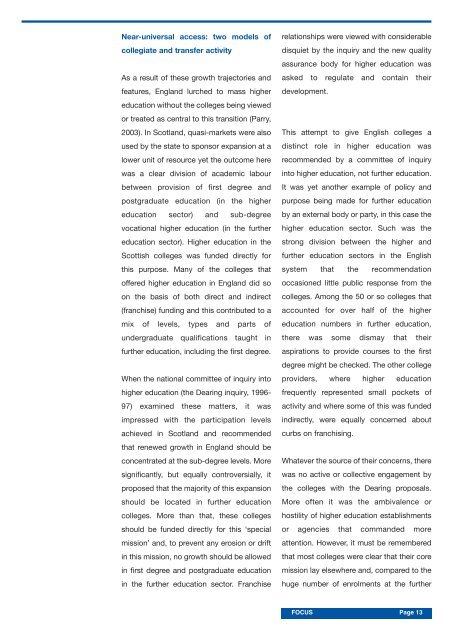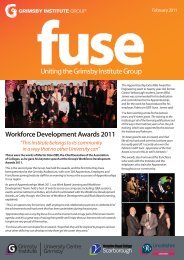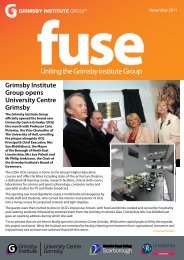Journal of Research & Scholarly Output 2006 - Grimsby Institute of ...
Journal of Research & Scholarly Output 2006 - Grimsby Institute of ...
Journal of Research & Scholarly Output 2006 - Grimsby Institute of ...
You also want an ePaper? Increase the reach of your titles
YUMPU automatically turns print PDFs into web optimized ePapers that Google loves.
Near-universal access: two models <strong>of</strong><br />
collegiate and transfer activity<br />
As a result <strong>of</strong> these growth trajectories and<br />
features, England lurched to mass higher<br />
education without the colleges being viewed<br />
or treated as central to this transition (Parry,<br />
2003). In Scotland, quasi-markets were also<br />
used by the state to sponsor expansion at a<br />
lower unit <strong>of</strong> resource yet the outcome here<br />
was a clear division <strong>of</strong> academic labour<br />
between provision <strong>of</strong> first degree and<br />
postgraduate education (in the higher<br />
education sector) and sub-degree<br />
vocational higher education (in the further<br />
education sector). Higher education in the<br />
Scottish colleges was funded directly for<br />
this purpose. Many <strong>of</strong> the colleges that<br />
<strong>of</strong>fered higher education in England did so<br />
on the basis <strong>of</strong> both direct and indirect<br />
(franchise) funding and this contributed to a<br />
mix <strong>of</strong> levels, types and parts <strong>of</strong><br />
undergraduate qualifications taught in<br />
further education, including the first degree.<br />
When the national committee <strong>of</strong> inquiry into<br />
higher education (the Dearing inquiry, 1996-<br />
97) examined these matters, it was<br />
impressed with the participation levels<br />
achieved in Scotland and recommended<br />
that renewed growth in England should be<br />
concentrated at the sub-degree levels. More<br />
significantly, but equally controversially, it<br />
proposed that the majority <strong>of</strong> this expansion<br />
should be located in further education<br />
colleges. More than that, these colleges<br />
should be funded directly for this ‘special<br />
mission’ and, to prevent any erosion or drift<br />
in this mission, no growth should be allowed<br />
in first degree and postgraduate education<br />
in the further education sector. Franchise<br />
relationships were viewed with considerable<br />
disquiet by the inquiry and the new quality<br />
assurance body for higher education was<br />
asked to regulate and contain their<br />
development.<br />
This attempt to give English colleges a<br />
distinct role in higher education was<br />
recommended by a committee <strong>of</strong> inquiry<br />
into higher education, not further education.<br />
It was yet another example <strong>of</strong> policy and<br />
purpose being made for further education<br />
by an external body or party, in this case the<br />
higher education sector. Such was the<br />
strong division between the higher and<br />
further education sectors in the English<br />
system that the recommendation<br />
occasioned little public response from the<br />
colleges. Among the 50 or so colleges that<br />
accounted for over half <strong>of</strong> the higher<br />
education numbers in further education,<br />
there was some dismay that their<br />
aspirations to provide courses to the first<br />
degree might be checked. The other college<br />
providers, where higher education<br />
frequently represented small pockets <strong>of</strong><br />
activity and where some <strong>of</strong> this was funded<br />
indirectly, were equally concerned about<br />
curbs on franchising.<br />
Whatever the source <strong>of</strong> their concerns, there<br />
was no active or collective engagement by<br />
the colleges with the Dearing proposals.<br />
More <strong>of</strong>ten it was the ambivalence or<br />
hostility <strong>of</strong> higher education establishments<br />
or agencies that commanded more<br />
attention. However, it must be remembered<br />
that most colleges were clear that their core<br />
mission lay elsewhere and, compared to the<br />
huge number <strong>of</strong> enrolments at the further<br />
FOCUS Page Page 13

















